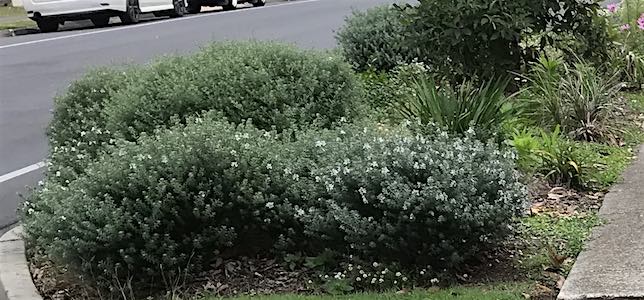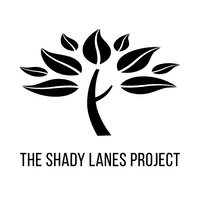In 2016, I began planting out the verge in front of my house. My motivation was simple – I enjoy gardening but dislike mowing.
I followed the various discussions and debates on verge planting, edible verges, and urban farming, while quietly monitoring what did well on my verge and how the local community reacted.
 Westringia is a hardy, low-growing, native shrub that provides flowers and habitat for bees, small birds and other wildlife. Occasional pruning keeps them bushy and the trimmings can be left to add to the mulch layer.
Westringia is a hardy, low-growing, native shrub that provides flowers and habitat for bees, small birds and other wildlife. Occasional pruning keeps them bushy and the trimmings can be left to add to the mulch layer.
Gradually, I refined my ideas about the issue.
Native plants for habitat had more benefits than food plants, verge underplanting helps street trees cool the area, and people respond well to flowers. Indeed, flowers are the ambassadors for your verge garden.
The ideal would be that whole strips of suburban roadsides merge together as corridors rather than the odd one here or there. Some councils have cottoned on to this as part of their attempts to tackle the urban heat effect and create wildlife habitat. However, scaling up from individual volunteer residents has an obvious hurdle – who would pay for the conversion and do the maintenance?
Meanwhile, I’d been reading about the Sustainable Development Goals (SDGs) and the emphasis on the interconnectedness of the goals.
Instead of arguing about environmental concerns versus social needs and jobs, creative solutions can address multiple goals with one action. There’s nothing new in this – kill multiple birds with one stone – but there’s probably a new buzzword for it. And for me, a lifetime in small business means the idea of leveraging multiple benefits out of actions and assets is second nature.
A turning point came when I did the MOOC, Tech for Good: The Role of ICT in Achieving the SDGs. It got me thinking about how my years working in online publishing and marketing with its evolving business relationships formed around open source software and affiliate marketing could be used to find solutions to the scaling and funding of nature strip projects.
Another question for any enterprise is the type of entity required. I’ve worked with businesses ranging from micro-enterprises to international corporations, franchises, social enterprises, and incorporated non-profit organisations. Different structures work better in different circumstances and a lot of thought has gone into how each one can fit into this project.
And so, The Shady Lanes Project, was born. At its simplest, it is the platform to grow and support a loose network of people and organisations who make things happen in their own communities while connecting with resources and ideas from further afield. The technology is the tool, the greatest value is in the people who use it.
Contact me here if you want to be involved or follow on Facebook or Linkedin.
Links:
- Why I won’t be growing an edible verge @brisbanecitylife.com.au (my garden blog)
- Street Trees need verge gardens too
- Why your verge should include flowers
- You can learn more about the Sustainable Development Goals (SDGs) at EDX SDG Academy
- Tech for Good: The Role of ICT in Achieving the SDGs @edx
